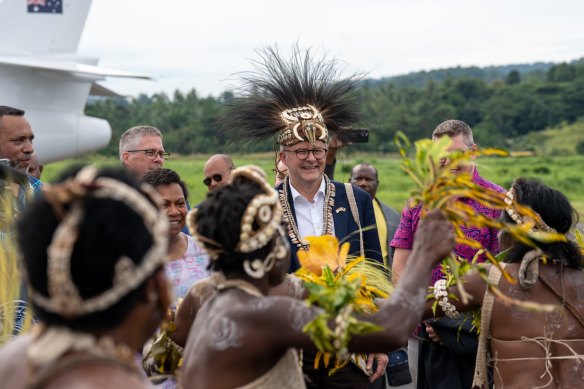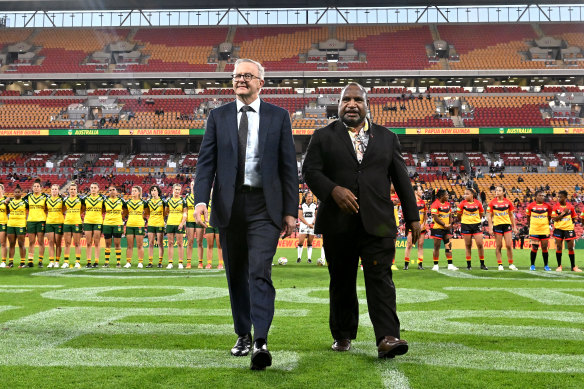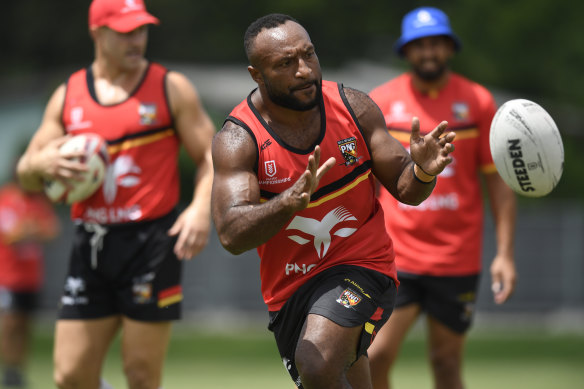This was published 1 year ago
Opinion
Why Papua New Guinea should – and shouldn’t – have a team in the NRL
Andrew Webster
Chief Sports WriterWhen the Prime Minister’s XIII men’s and women’s teams played in Port Moresby in September, their security detail issued strict advice: don’t give your jersey to someone in the crowd because it could lead to violence, possibly death.
The anecdote highlights why Papua New Guinea should be handed the NRL’s 18th franchise – and why it should not. It shows how one team could have a transformative influence in a rugby league-mad country – or could be a money bonfire for decades to come given the logistical nightmare of playing there.
These are interesting times for the NRL and its all-powerful chairman, Peter V’landys, as the ARL Commission ponders expansion to 18 teams, most likely from 2027 onwards.
V’landys’ blossoming bromance with Prime Minister Anthony Albanese suggests PNG is in the box seat. A decision on the 18th franchise is expected in the next six months but, as one figure from a rival bid huffs: “PNG is a fait accompli.”
Why? Mostly because of money. What else?
PNG Prime Minister James Marape often plays the China card in discussions with Australia and is now leveraging it, seemingly, to win an NRL club licence.

Australian Prime Minister Anthony Albanese during a January visit to Papua New Guinea.Credit: PMO - Supplied
Not one to back away from an exciting game of diplomacy and international intrigue, Albanese has flagged $600 million of Department of Foreign Affairs and Trade funding over the next decade to support the bid.
So let’s be clear: $60 million a year. Not all of it will be invested in PNG rugby league, with some of the funds distributed throughout the Pacific region, but that’s a carrot V’landys can’t ignore.
Nevertheless, a few questions need to be asked of the Australian government.
For starters, why should the Australian taxpayer fund the establishment of a professional rugby league team in another country? And especially so when the country we live in is gripped by a cost-of-living crisis?
Personally, I would like to see $60 million given to the St George Illawarra Rugby League Football Club so they can buy some halves. Thank you.

Prime Minister Anthony Albanese and Papua New Guinean Prime Minister James Marape at Suncorp Stadium before the Australian Women’s PM’s XIII and PNG Women’s PM’s XIII game last September.Credit: Getty Images
DFAT already sinks millions into various sports across the Pacific region, including the PNG Hunters, who play in the Queensland state league.
Furthermore, the cornerstone of the PNG bid is how the franchise will be brimming with dollars from gold- and oil-company sponsorship if they are granted a licence. If that’s so, let Shell, or their equivalent, foot the bill.
There are questions, too, for the NRL.
Logistically, a PNG team seems as easy to run as Woodstock ’94. For the first five years, the team would live and train in Cairns before flying in and out of Port Moresby via private jet. They are footballers, not Kardashians.
And after that? Will the city be safe enough to entice players from other clubs? If Canberra struggles to attract players because of its location, what about the PNG capital?
Then there’s these sobering questions: what if they suck? What if they win three wooden spoons? What happens when the politicians from both countries who hype the merits of a PNG team today are tipped out of government tomorrow?
The real problem with admitting a PNG team is it will mean snubbing – again – a rugby league powerhouse that’s ready to roll off the back of the truck.

Next into the NRL? Valentine Richard training with Papua New Guinea.
And no, it’s not the North Sydney Bears.
On paper, the Brisbane Tigers deserve to be the next team admitted. They have a storied 90-year history, winning premierships and banking cheques along the way.
They have more than 33,000 members, $25 million in the bank and $58 million in assets.
The Broncos and Dolphins might think it’s too early for a third Brisbane team, but the Redcliffe-based side’s success has shown that Queenslanders will attend rugby league every weekend of the year. You just have to give them a game.
Of greater significance to rugby league is that the Tigers can fortify the south-west corridor of Brisbane, an area that has become a battleground of sorts between the NRL and AFL.
The Brisbane Lions last year moved into their new $80 million training facility at Springfield in Ipswich while the AFL continues to aggressively shore up schools in the same way it targeted western Sydney a decade ago.
When former chief executive Gillon McLachlan said he wanted the AFL to “own” Queensland, he wasn’t joking.
V’landys, who loves a fight with the AFL more than a feed at the White House, should heed his words. Is he prepared to invest time and energy into a PNG team while the arch-enemy sneaks into Troy?
Like the NSWRL, the QRL is regularly at war with the NRL over funding.
Last week’s skirmish involved NRL chief executive Andrew Abdo, who told Toowoomba’s Western Clydesdales via letter their existence in the Queensland Cup wasn’t “in the best interests of the game”. It means the QRL will need to pick up the slack, so the club doesn’t fold.
The Brisbane Tigers have attempted four times in the past 18 months to form a joint venture with the PNG bid, which says everything you need to know about the bidding process.
A PNG side competing – and winning – in the NRL would be a great moment for the game. Let’s hope it’s not used up like so much of this beautiful country.
Sports news, results and expert commentary. Sign up for our Sport newsletter.